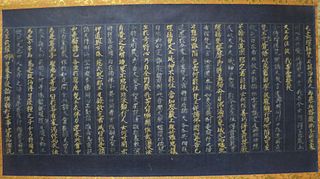Suttas from the Sutta Pitaka of the Pali Canon.
Nikāya is a Pāli word meaning "volume". It is often used like the Sanskrit word āgama to mean "collection", "assemblage", "class" or "group" in both Pāḷi and Sanskrit. It is most commonly used in reference to the Pali Buddhist texts of the Tripitaka namely those found in the Sutta Piṭaka. It is also used to refer to monastic lineages, where it is sometimes translated as a 'monastic fraternity'.
The Aṭṭhakavagga and the Pārāyanavagga are two small collections of suttas within the Pāli Canon of Theravada Buddhism. They are among the earliest existing Buddhist literature, and place considerable emphasis on the rejection of, or non-attachment to, all views.

The Sutta Pitaka is the second of the three divisions of the Tripitaka or Pali Canon, the Pali collection of Buddhist writings of Theravada Buddhism. The other two parts of the Tripiṭaka are the Vinaya Piṭaka and the Abhidharma Piṭaka. The Sutta Pitaka is also known as 'Buddhavacana' or words of Buddha and contains more than 10,000 suttas (teachings) attributed to the Buddha or his close companions.

The Rhinoceros Sutra also known as The Rhino Sutra is a very early Buddhist text advocating the merit of solitary asceticism for pursuing enlightenment as opposed to practicing as a householder or in a community of monastics. The goal of this was to become a pratyekabuddha, who wandered alone through the forest like a rhinoceros. In fact, it is possible this sutra is one identified in the Chinese translation of the Mahāsāṃghika vinaya and thus was also referred to with a Gāndhārī name similar to Pracegabudha-sutra.

In Buddhism, an āgama is a collection of Early Buddhist Texts.

The Digha Nikaya is a Buddhist scripture, the first of the five nikayas, or collections, in the Sutta Pitaka, which is one of the "three baskets" that compose the Pali Tipitaka of (Theravada) Buddhism. Some of the most commonly referenced suttas from the Digha Nikaya include the Maha-parinibbana Sutta, which described the final days and death of the Buddha, the Sigalovada Sutta in which the Buddha discusses ethics and practices for lay followers, and the Samaññaphala, Brahmajala Sutta which describes and compares the point of view of Buddha and other ascetics in India about the universe and time ; and the Poṭṭhapāda Suttas, which describe the benefits and practice of samatha meditation.

The Majjhima Nikāya is a Buddhist scripture, the second of the five nikayas, or collections, in the Sutta Pitaka, which is one of the "three baskets" that compose the Pali Tipitaka of Theravada Buddhism. Composed between 3rd century BCE and 2nd century CE. This nikaya consists of 152 discourses attributed to the Buddha and his chief disciples.

The Saṃyukta Nikāya/Samyutta Nikaya is a Buddhist scripture, the third of the five nikayas, or collections, in the Sutta Pitaka, which is one of the "three baskets" that compose the Pali Tipitaka of Theravada Buddhism. Because of the abbreviated way parts of the text are written, the total number of suttas/sūtras is unclear. The editor of the Pali Text Society edition of the text made it 2889, Bodhi in his translation has 2904, while the commentaries give 7762. A study by Rupert Gethin gives the totals for the Burmese and Sinhalese editions as 2854 and 7656, respectively, and his own calculation as 6696; he also says the total in the Thai edition is unclear. The suttas/sūtras are grouped into five vargas/vaggas, or sections. Each varga/vagga is further divided into samyuttas/saṃyuktas, or chapters, each of which in turn contains a group of suttas/sūtras on a related topic.

The Anguttara Nikaya is a Buddhist scripture, the fourth of the five nikayas, or collections, in the Sutta Pitaka, which is one of the "three baskets" that comprise the Pali Tipitaka of Theravada Buddhism. This nikaya consists of several thousand discourses ascribed to the Buddha and his chief disciples arranged in eleven "books", according to the number of dhamma items referenced in them.
The brahmavihārās are a series of four Buddhist virtues and the meditation practices made to cultivate them. They are also known as the four immeasurables or four infinite minds. The Brahma-viharas are:
Anussati means "recollection," "contemplation," "remembrance," "meditation", and "mindfulness". It refers to specific Buddhist meditational or devotional practices, such as recollecting the sublime qualities of the Buddha, which lead to mental tranquillity and abiding joy. In various contexts, the Pali literature and Sanskrit Mahayana sutras emphasise and identify different enumerations of recollections.
The Ānāpānasati Sutta (Pāli) or Ānāpānasmṛti Sūtra (Sanskrit), "Breath-Mindfulness Discourse," Majjhima Nikaya 118, is a discourse that details the Buddha's instruction on using awareness of the breath (anapana) as an initial focus for meditation.

The Dhammacakkappavattana Sutta is a Buddhist text that is considered by Buddhists to be a record of the first sermon given by Gautama Buddha. The main topic of this sutta is the Four Noble Truths, which refer to and express the basic orientation of Buddhism in a formulaic expression. This sutta also refers to the Buddhist concepts of the Middle Way, impermanence, and dependent origination.
The Satipaṭṭhāna Sutta, and the subsequently created Mahāsatipaṭṭhāna Sutta, are two of the most celebrated and widely studied discourses in the Pāli Canon of Theravada Buddhism, acting as the foundation for contemporary vipassana meditational practice. The Pāli texts of the Satipaṭṭhāna Sutta and the Mahāsatipaṭṭhāna Sutta are largely similar in content; the main difference being a section about the Four Noble Truths in the Observation of Phenomena (Dhammānupassana), which is greatly expanded in the Mahāsatipaṭṭhāna Sutta. These suttas (discourses) stress the practice of sati (mindfulness) "for the purification of beings, for the overcoming of sorrow and lamentation, for the extinguishing of suffering and grief, for walking on the path of truth, for the realization of nibbāna."
In English translations of Buddhist texts, householder denotes a variety of terms. Most broadly, it refers to any layperson, and most narrowly, to a wealthy and prestigious familial patriarch. In contemporary Buddhist communities, householder is often used synonymously with laity, or non-monastics.

The Anattalakkhaṇa Sutta (Pali) or Anātmalakṣaṇa Sūtra (Sanskrit), is traditionally recorded as the second discourse delivered by Gautama Buddha. The title translates to the "Not-Self Characteristic Discourse", but is also known as the Pañcavaggiya Sutta (Pali) or Pañcavargīya Sūtra (Skt.), meaning the "Group of Five" Discourse.
Luminous mind is a Buddhist term which appears in a sutta of the Pali Anguttara Nikaya as well as numerous Mahayana texts and Buddhist tantras. It is variously translated as "brightly shining mind", or "mind of clear light" while the related term luminosity is also translated as "clear light" in Tibetan Buddhist contexts or, "purity" in East Asian contexts. The term is usually used to describe the mind or consciousness in different ways.
Early Buddhist texts (EBTs), early Buddhist literature or early Buddhist discourses are parallel texts shared by the early Buddhist schools. The most widely studied EBT material are the first four Pali Nikayas, as well as the corresponding Chinese Āgamas. However, some scholars have also pointed out that some Vinaya material, like the Patimokkhas of the different Buddhist schools, as well as some material from the earliest Abhidharma texts could also be quite early.